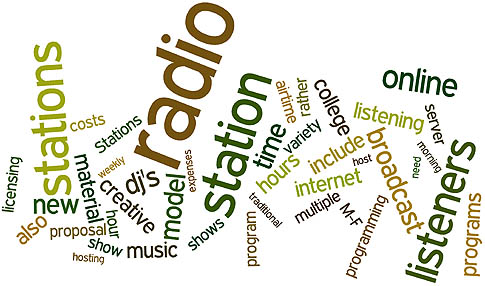
Virtual
Radio Network
![]()
![]()
![]()
![]()
During and after college I had the privilege of being able to host a weekly radio program. In college the costs were mainly a choice between buying new music or eating better meals. Later, expenses also included buying airtime on a local AM radio station. This easily ran hundreds of dollars an hour even twenty years ago. Selling commercial time to cover such a show is frustrating and extremely time-consuming - which is why stations want to sell you a block of time outright...
While you can still purchase airtime wedged between a Portuguese soccer channel and favorite polka hits, there are now many unique online radio opportunities too. This is a new, far more affordable alternative to commercial airtime. Broadcasting this digital content online requires id3 tagging and license fees for material licensed through SESAC, BMI, and ASCAP. Rates depend on whether the material is broadcast or delivered as a podcast. Aggregate listening hours and/or simultaneous listeners also affect the price. A few online services offer packaged pricing with royalties based on concurrent listeners or listening hours, including Live365, swcast, and Loudcaster. A few include server space These models simplify the licensing and reporting process with a few tradeoffs though...
Using Live365 as an example, individual online stations prepay the licensing fee and storage costs for uploaded material. Many stations have a playlist with less than ten hours. After listening for a day, it's generally time to move on to another station until the playlist is refreshed - which may be weeks or months away since uploading new music is rather time-consuming and requires some organizational skills. Stations start with a 7-Hour broadcast hosting up to 3 simultaneous listeners - which is more than some 'real' radio stations playing the same 20 A-List songs every two hours with B-List titles and ads sprinkled in for variety can claim. Without the need for advertising and its attendent focus on demographics and market-share, you have the freedom to depart from this model and set a much higher standard, employing creative playlists and variety... Costs scale up as the number of listeners and song list expand. Besides escalating costs with growing market share, the biggest downside of this model is an endless series of commercials that your 'non-paying' listeners will have to endure.
I glossed over two other differences between traditional and Internet radio. The most obvious is that few internet radio listeners are web-ebnabled to listen live in their car. The second is that internet radio is generally built around discrete radio stations competing for audience share rather than a traditional program or show structure with multiple hosts and segments on a single station. In college radio, there is a camraderie where dj's hope to pull in listeners from previous and subsequent programs. Commercial radio has an equivalent complementary bridge with dj's hosting drive time and morning programs.

Following is a proposal that combine a leaner (cheaper) broadcast model with an alternative internet radio strategy that breathes new life and creativity into online programming. It also anticipates a time in the near future when internet radio is widely accessible in your car and portable listening device much like satellite radio is today. It could also overcome the tendency for online radio to consist of playlists in lieu of intentional programming and style.
-------------------------------------
Proposal - Virtual Internet Radio Stations
The overall proposal is intended to deliver the highest professional radio standard possible, foster new music programs, and provide a training ground for dj's - all in an environment akin to college radio and having a shared financial model similar to promotional compilation cd's.
This might take the form of multiple music programs
in 64k mp3Pro with a 1 to 4 hour duration and predefined station id's at the top and
bottom of the hour. These segments would then be assembled into individual stations
with a live feed from a server for transmission on existing channels and potentially even
satellite or cable broadcast delivery. This model could overcome several hurdles at
once.
- Shared server and station licensing reduces cost per host
- Shows complement rather than compete
- Shows are constructed with a genuine broadcast feel
- Greater artist variety means broader appeal and more knowledgable listeners
- Programming overall is more dynamic, with shows updated weekly
- Limited advertising across multiple stations possible - could defray expenses
Fundamental ideas include a station manager with
creative control over the branding of each station and 4 supporting mentors who provide
creative and technical assistance. These day managers would fill slots by invitation
from a pool of emerging dj's and determine program order within their schedule block:
![]() - M-F morning
- M-F morning
![]() - M-F evening
- M-F evening
![]() - M-F overnight
- M-F overnight
![]() - Sat / Sun
- Sat / Sun
Other elements of this proposal include:
- Stations structured by genre (e.g. Top40, Rock, Electronica, Alternative, Soft)
- Short 30-second PSA's for shows on the station as well as the other stations
- A freeform station for specialty material (e.g. comedy, industrial, demos)
- A talk-only station for creative, non-musical programming (e.g. NPR-style)
- One or more developmental stations where learning dj's could:
![]() - Practice show construction, id3
tagging, file conversion, and uploads
- Practice show construction, id3
tagging, file conversion, and uploads
![]() - Develop a following
- Develop a following
![]() - Demonstrate commitment to regularly
update shows
- Demonstrate commitment to regularly
update shows
![]() - Alternates to substitute when
regular hosts need a break
- Alternates to substitute when
regular hosts need a break
Online resources with legal and technical information that might be of interest include
the following:
![]() http://radioo.org/
http://radioo.org/
![]() http://www.swcast.net/broadcast/streaming.html
http://www.swcast.net/broadcast/streaming.html